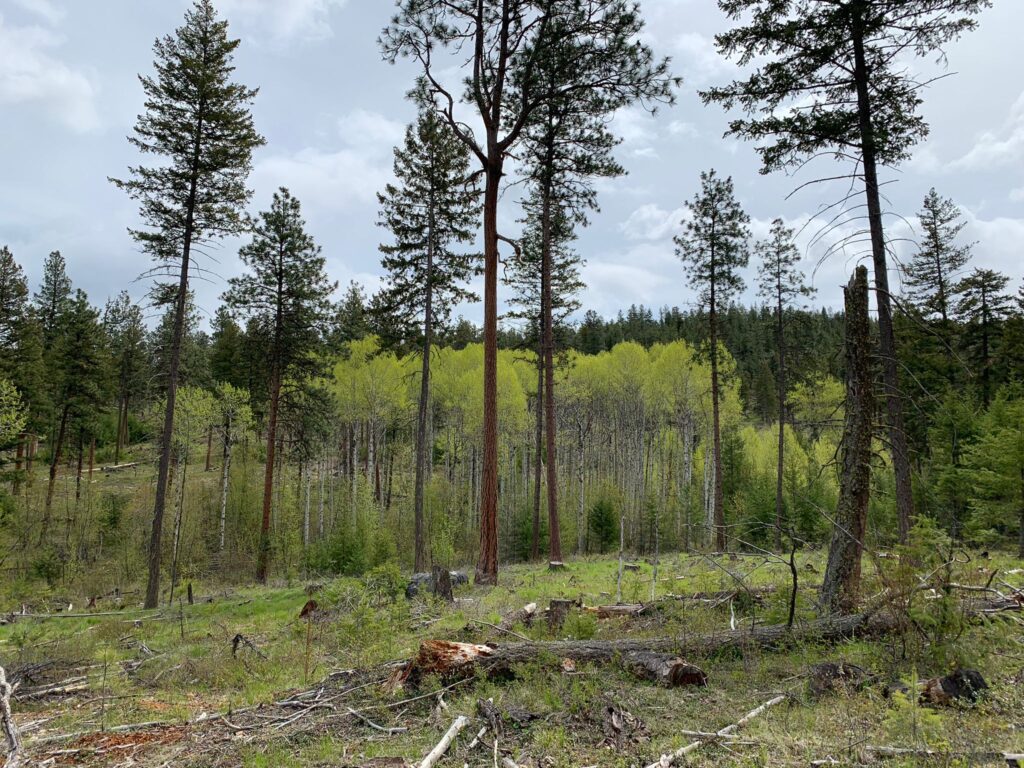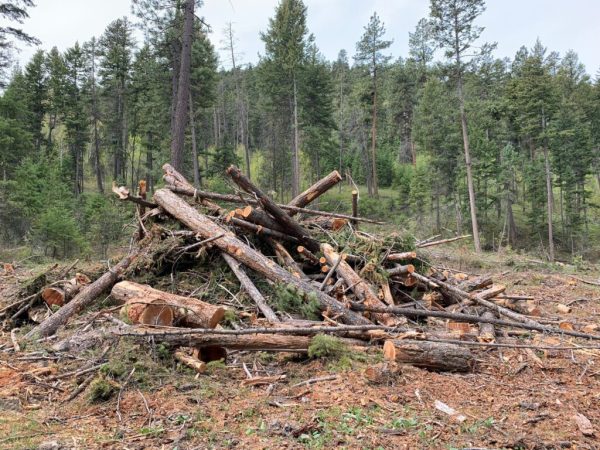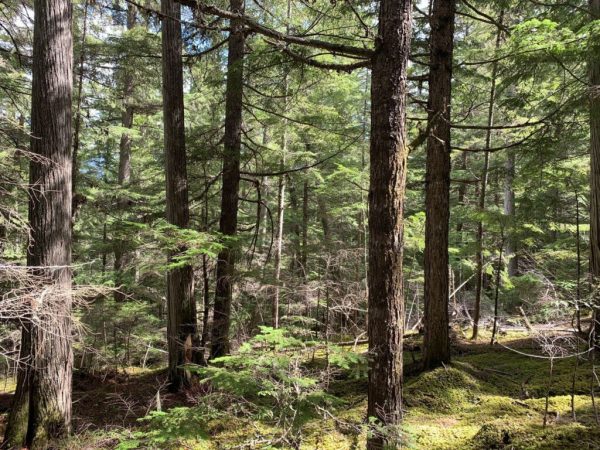
BC bioenergy: The case, controversy and considerations from a sustainability expert
May 20, 2022
By Shauna Matkovich
Italy-based forester and sustainability expert Shauna Matkovich shares observations from her recent trip to B.C. to explore the opportunities and challenges for bioenergy in the province.
 Fire managed landscape in Interior British Columbia, where some harvesting residues have been removed for bioenergy production after the higher value logs have gone on to other end uses. Photo by Shauna Matkovich.
Fire managed landscape in Interior British Columbia, where some harvesting residues have been removed for bioenergy production after the higher value logs have gone on to other end uses. Photo by Shauna Matkovich. I was recently on an advisory visit, reviewing the challenges and opportunities around the bioenergy sector in British Columbia. The study explored the complicated issues pertaining to the B.C. forest industry, such as Indigenous reconciliation, biodiversity and old-growth management, fire management and climate change, high-value versus low-value wood products, jobs, and moving from a sustainable forest management regime of timber management to forest ecosystem management.
The case and controversy for bioenergy
There has been an upswing in bioenergy use in recent years as a decarbonization strategy for the highly emitting fossil energy sector. The issue, however, is not so clearcut and is causing a lot of debate. The IPCC in their latest report explain that bioenergy has an important role to play in decarbonizing the energy sector. This was recognized back in 2012, when an IPCC special report on renewable energy sources and climate change mitigation stated that the use of biomass residues and wastes and advanced conversion systems are able to deliver 80 to 90 per cent emission reductions compared to the fossil energy baseline (IPCC, 2012). Though certainly the science has become more sophisticated in the past 10 years, likewise the risks are becoming much better understood. The IPCC 2022 report draws attention to the risks of poor land management that doesn’t balance the need for various resources (IPCC, 2022). The report notes that bioenergy may increase or decrease emissions depending on the scale at which it is implemented, the technology used, the fuel displaced, and how and where the biomass is produced.
What I witnessed in B.C. showed a positive story, albeit with room for improvement. On the pro-bioenergy side, I observed important elements such as the use of forest waste and residue from the timber industry, job creation and fire management. On the case against bioenergy is the understanding that B.C. doesn’t need the energy itself due to its robust hydroelectric energy systems. On the opportunities side for bioenergy, there is the discussion of the industry developing partnerships with First Nations, supporting ecosystem management and fire management as well as others. Let’s dig into the debate and see what takeaways there are more widely for the forest sector.
Climate, fire and the role of bioenergy
I’m hesitant to quote any numbers here because, quite frankly, I was bombarded with sophisticated carbon modelling outputs that are the result of several decades of forest carbon modelling across Canada, and I don’t want to misquote this information. One clear very important take-away however, is that B.C.’s forests are burning at increasingly catastrophic rates, largely the result of decades, if not centuries of forest fire suppression. If left to nature, much of B.C.’s forests would experience frequent, low-grade fires to maintain the natural ecosystem. These natural “maintenance” fires are being suppressed, resulting in unnaturally dense forests, with high surface fuel loads – inviting this surge in catastrophic wildfires with significant emissions.
The bioenergy industry has an opportunity here to absorb some of the finer materials – waste and residues not used by the higher value timber industry – to reduce fuel load in the forest and create a value-added product at the same time. This also plays a role when you consider that the conventional approach to managing waste and residuals in timber management operations in B.C. is to burn slash piles. This is after substantial residues already remain scattered onsite (for those of you incorrectly imagining a post-harvest site in B.C. to be swept clean of tops, branches, and other woody biomass). Bioenergy creates an opportunity to reduce the emissions of simply burning this material at roadside by converting it into a renewable energy source.

A typical slash pile, left at roadside waiting to be burned. This material can be utilized by the bioenergy sector in the right circumstances, creating value addition, jobs, and reducing the smoke impact on local communities. Photo by Shauna Matkovich.
Economic efficiency
Certainly, logistics plays a part in the decision to remove waste and residues from the forest in the first place. From a climate perspective, if it costs more in emissions to transport the debris to the processing facility, process it, and then transport it again to where it will be consumed for energy, the carbon story doesn’t stack up.
This is the same when crunching the traditional numbers. I was quoted some current prices indicating that biomass is worth about half the price of the equivalent volume of pulp wood and the same volume is seven times less than high-value peeler logs. If you build in the stumpage paid to the government (essentially B.C.’s profit share from harvested wood volumes), transport and processing costs, if the biomass isn’t nearby a production facility, it’s hardly worth removing it. The dream scenario is a bioenergy processing plant adjacent to a sawmill that can feed the mill’s sawdust directly into the plant.
How does bioenergy influence biodiversity
The discussion on bioenergy and biodiversity is not an easy one. When managing for multiple objectives in a forest, managing for biodiversity and managing for carbon sequestration and storage can be at odds. For example, planting fast-growing, carbon-accumulating tree species in an intensive regime could be detrimental to biodiversity – displacing less productive vegetation species that provide rich habitats and ecosystem function.
In my view, the clear opportunity for the bioenergy sector to enhance biodiversity in B.C. relates to the previous point of fire management. I had the benefit of seeing some sites that had been managed under special projects, where industry was working together with the local First Nation to carry out a silviculture regime that harvested trees for high-value products, maintained trees at a density similar to a natural ecosystem, and removed the excessive residual waste (which would normally be burned at roadside) by making it available to the biomass industry. Here, the biomass energy supported the transition of an unnaturally dense forest to one that is more attuned to the natural ecosystem.
The debate on whether short-rotation coppice systems managed purely for bioenergy, or monoculture plantation where residuals go to biomass were not discussed, because these systems, by and large, don’t depict forest management in B.C. However, you would be hard pressed to demonstrate biodiversity improvement from the production of bioenergy from biomass plantations and monoculture residuals at face value.

Controversial old-growth deferral area. This area has been deferred from harvest due to its old-growth characteristics. The site has had both a history of fire and harvesting in the past 100 years. Photo by Shauna Matkovich.
Social conundrums
The bioenergy industry has faced criticism in B.C. On the one hand, it creates jobs and adds value to a product that would have otherwise been burned in the forest. On the other hand, some criticize the industry for converting whole logs or even whole trees to energy biomass. The other argument against the sector is that it doesn’t feed B.C.’s energy supply because renewable energy is already alive and well in the province in the form of plentiful hydroelectricity – thus, it is exported.
Now let’s get one thing straight: logs do make it into the fibre mix in B.C. to create bioenergy. But, let’s also be clear that these logs have previously been scrutinized for higher and better use (see above pricing: pulp nearly 2x and timber nearly 7x more valuable). In cases where the waste material (rotten, low-value, or small-diameter logs) is close enough to the processing facility to make it economically viable, these waste logs may be used. However, in the cases I observed, the predominant fibre source came from sawmill residues – again, adding value to something that otherwise would have been waste. British Columbians (mostly) don’t have a problem exporting lumber – why should they in exporting its waste product that has been manufactured (think jobs) into a value-added (think economy) substitute fossil fuel energy (think decarbonization)?
There is opportunity here for the industry to be more outspoken on its fibre supply procurement policies, the positive impact it is having on local, rural economies, and its ability to support the shift to ecosystem management.
Considerations for forest companies considering expanding their product line to include bioenergy
What can other regions learn from the bioenergy sector in British Columbia? The following is a list of points forest companies might consider if they are thinking about adding bioenergy to their product offerings.
- Climate and economic case – are the forests (and/or milling industry) located sufficiently close to the processing facility to lower the logistical carbon and economic footprints of biomass extraction, transportation, and manufacturing?
- Market – as a forest company, would there be demand for waste, residues, and pre-commercial thinning material to supply bioenergy?
- Legal framework – does the government help or hinder the bioenergy sector? (Stumpage subsidies would be a good idea)
- Biodiversity and ecosystem management – can incorporation of bioenergy into a forest company’s management regime legitimately improve biodiversity of the forest, or at the very least, do no harm?
- Social considerations – How would supplying bioenergy be perceived socially? If waste, residues and pre-commercial thinning material would have been used locally for firewood, fence poles, etc., (like in several of the tropical geographies where most of my work is focused) there is likely to be push back. Is there an opportunity to create jobs? Is there an opportunity to partner with local Indigenous groups?
- Fibre supply – Especially if considering investing into a processing facility, is there sufficient fibre supply? (Either from surrounding industry, pre-commercial thinning material, waste, and residue from harvest)
If you are looking for ways to maximize the value from the forests you manage or invest into, whether that be economic, climate, nature, or social value (or all of the above), please reach out and we can discuss the opportunities best suited for your unique context. Bioenergy is only one value addition that forest managers and investors can incorporate. Let’s see what your forest can generate.
This article originally appeared on The ForestLink. Republished with permission.
 Shauna Matkovich is the founding director of The ForestLink. She is a forester and sustainability expert with more than 15 years working in cross-continental sustainable forest management, global forest investment management, and agricultural development with an expertise in tropical developing countries. She has worked for one of the world’s leading forest investment companies, as well as with several forest industry companies.
Shauna Matkovich is the founding director of The ForestLink. She is a forester and sustainability expert with more than 15 years working in cross-continental sustainable forest management, global forest investment management, and agricultural development with an expertise in tropical developing countries. She has worked for one of the world’s leading forest investment companies, as well as with several forest industry companies.
Shauna first studied as a forester at the University of British Columbia, and since has earned a double master of science in agricultural development from the University of Copenhagen, and tropical forest management from the Technical University of Dresden, and advanced project management training from Implement Consulting Group.
Print this page